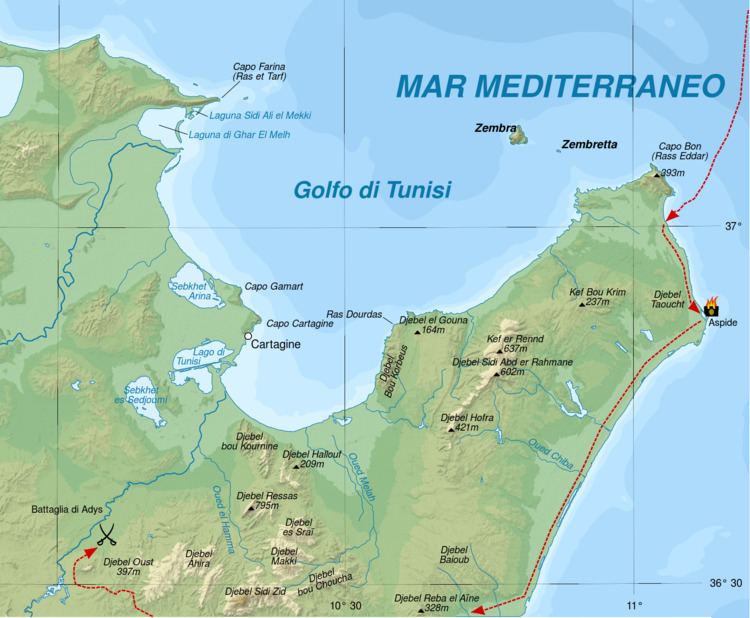Date 255 BC | ||
 | ||
15,000 Infantry500 Cavalry 5,000+ Infantry500 Cavalryunknown number of elephants Similar Battle of Tyndaris, Battle of the Lipari Islands, First Punic War, Battle of Agrigentum, Battle of Drepana | ||
Battle of adys
The Battle of Adys (or Adis) was fought in 255 BC between Carthage and a Roman army led by Marcus Atilius Regulus. Regulus inflicted a crushing defeat upon the Carthaginians, who then sued for peace. However, the First Punic War would continue because the terms offered by Regulus were so harsh that the people of Carthage resolved to keep fighting.
Contents
Background
In 256 BC, a Roman army under consuls Lucius Manlius Vulso and Marcus Atilius Regulus invaded the Carthaginian homeland in Africa. The Roman army soon forced the capitulation of Clupea, a town 40 miles east of Carthage. After setting up defences for the city and gathering some 20,000 slaves and herds of cattle from the countryside, they received instructions from Rome that Vulso was to set sail for Rome, taking most of the fleet, including all the transports, with him. Regulus, on the other hand, was to stay with 15,000 infantry and 500 cavalry.
By now, Carthage had recalled the general Hamilcar and his 5,000 Infantry and 500 cavalry from Sicily to join with generals Bostar and Hasdrubal in Africa. The army consisted of mercenaries, African light infantry, militia, cavalry, and elephants. The combined Carthaginian force set about organizing the defences of Adis, a city 40 miles southeast of Carthage, that was now under threat of a Roman siege. Despite possessing superior cavalry and elephants, the Carthaginians took up position on a hill overlooking the plain of Adis. The lack of training and decentralized command structure reflected poorly for the effectiveness of the army. The Carthaginians determined to resist and not allow further destruction by the Romans.
Battle
Unknown to the Carthaginians, the Romans quickly deployed their force around the hill under cover of darkness, and attacked from two sides at dawn. The Carthaginians held their ground in a stalemate for a while, and even pushed back a Roman legion. This gap in the battle lines allowed for the unchallenged elephants and Carthaginian cavalry to escape. But eventually the Carthaginians were crushed and fled the site. The Romans pursued for some time, and then looted the enemy camp. Encountering no resistance, the Roman army continued on a march to Carthage, stopping at Tunis.
Aftermath
This defeat caused great turmoil in Carthage. The Numidians rose up against their overlords and refugees from the countryside flooded the city. This great population increase coupled with a ravaged countryside led to a food crisis and the possibility of an outbreak of disease. Despite these threats, Regulus and his army of two legions had little chance of reducing the city without reinforcements. Worse, his consulship would soon be up and he would not receive the glory for ending the war. Negotiations ensued between the parties with Regulus demanding that Carthage cede Sicily, Corsica and Sardinia, renounce their navy, pay an indemnity, and sign a vassal-like treaty. However, Carthage refused.
Assessment
The opening move of the Carthaginians to create a fortified position on the hill could have ultimately helped their position. The base was sound, but the natural features (ravines and rugged outcrops) neutralized the most potent element of the Carthaginians land forces, their cavalry and elephants. Consequently, the Roman army saw an opportunity to exploit their heavy infantry to smash the trapped enemy.
